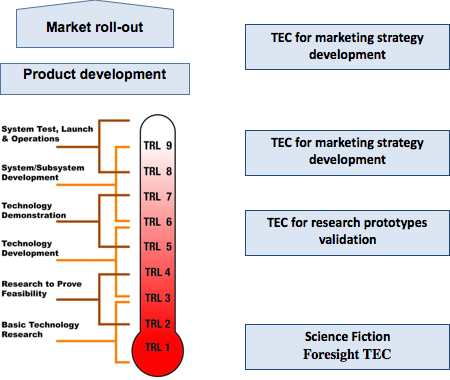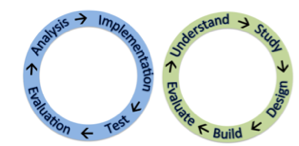TEC is a very effective instrument for technology representatives (scientists, developers, innovation and marketing agents) to establish direct contacts to potential users of the technologies. This is especially true when it comes to the development of new products/services with the application of the User Centred Design methodology.
User-centered design (UCD, often called User Experience Design, UED) is a research and development methodology that provides guidance through the design processes in which users’ needs become the major influence in how a design of a product/service/system takes shape. Depending on the project at hand, there are different descriptions of the UCD methodology, but common for all of them is that they have shown to be advantageous when designing and developing Human-Machine Interfaces in general.
UCD contains several phases or steps. In some models, the cyclic methodology contains an initial step called “understanding” which is typically used to achieve a common ground between the project stakeholders. The first part of the methodology contains a holistic analysis of the user needs, the development of abstract yet concrete description of the users – persona – as well as formulations of scenarios allow different typically diverse project stakeholders to gather around a realistic descriptions of what should be achieved. Initial stages of the UCD methodology include different light-weight actions that allow avoiding creating complete functional systems including paper mockup and wizard-of-oz (WOZ) experiments.
The UCD cycle is iterative and repeated several times to improve aspects like usability or user experience. Hereby the results from the evaluation phase are taken into account for the requirement analysis of the next cycle.
Cyclic User-Centred Design process
If usability, functionality and other kinds of testing and evaluation are common in RTD activities, evaluation of user experience, as defined by the standard ISO 9241-210, is not common. Moreover, very few (if any) references about applying the TEC concept for that purpose within the UCD cycle can be found. Therefore, the innovation of SIforAGE is mainly related to the modification of UCD methodology by integrating the TEC activities in the UCD cycle for user experience evaluation.
We believe that applying user experience evaluation methodologies, above all – TEC, there is an opportunity to establish direct contacts between technology designers and developers, from one side, and target users, on the other side, at a very early stage of development, thus significantly increasing chances for technology acceptance and market success. This is especially true when it comes to the development of solutions/services targeting older users, taking into account specific requirements and challenges older people face dealing with new technologies.
Also, the cyclic application of the TEC methodology can be seen through the technology maturation perspective. This view integrates all stages of new technology development stretching from blue-sky research through applied research and technology development down to innovation and market roll-out.

Place and role of TECs on the TRL scale
The figure above combines the definition of Technology Readiness Levels (TRLs) widely used nowadays by various stakeholders and changing roles TECs could play following the technology development and maturation process. As an example, the place of the SIforAGE’s TEC4 is highlighted. This view is common for the technology side and demonstrates the value technology developers/representative can yield applying the TEC methodology. It is also important to keep in mind that having realized the value of engaging with target users at an early stage (e.g. more market relevant and commercially successful products/services targeting older user group), the industry will be motivated to use the TEC engagement approach on a purely commercial basis.
